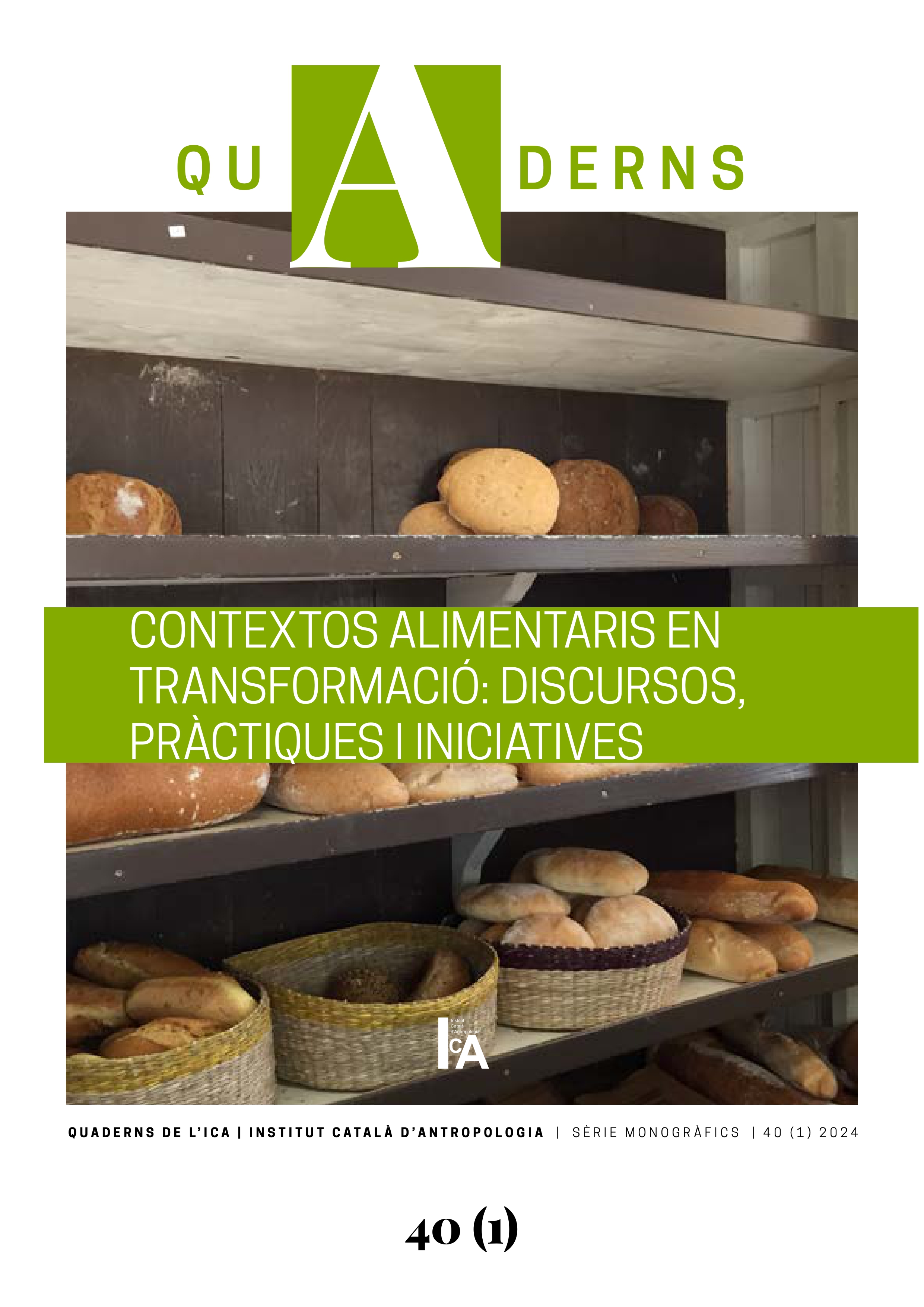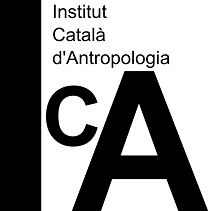De la citta a la pica. Consumos, agentes y categorías
DOI:
https://doi.org/10.56247/qua.467Paraules clau:
Pica, trastornos alimentarios, no-comestible, geofagia, amilofagia, pagofagiaResum
El presente artículo propone un abordaje antropológico
del consumo humano de sustancias no-comestibles, o
alotriofagia; y de la pica como su forma de sanción médica.
Para ello hemos realizado una revisión sobre esta práctica
alimentaria a partir del análisis de los documentos históricos y la literatura científica disponibles sobre el objeto de estudio; centrándonos en el tipo de sustancias consumidas, los agentes involucrados y su categorización. A lo largo de nuestra investigación hemos podido constatar la escasez de estudios antropológicos centrados en esta materia y la gran disparidad de argumentos científicos en cuanto a su abordaje y definición. Consideramos que el estudio de esta “anomalía” alimentaria puede proporcionarnos claves acerca de las lógicas que determinan nuestras prácticas alimentarias.
Descàrregues
Global Statistics ℹ️
|
272
Views
|
156
Downloads
|
|
428
Total
|
|
Referències
Abrahams, W., & Parsons, J. (1996). Geophagy in the Tropics: A Literature Review. The Geographical Journal, 162(1), 63-72. DOI: https://doi.org/10.2307/3060216
Andrade, C., & Srihari, B. S. (2001). A preliminary survey of rhinotillexomania in an adolescent sample. Journal of Clinical Psychiatry, 62(6), 426-431. DOI: https://doi.org/10.4088/JCP.v62n0605
Anell, B., & Lagercrantz, S. (1958). Geophagical Customs. Studia Ethnographica Upsaliensia.
Asociación Americana de Psiquiatría (APA). (1980). DSM-III: Diagnostic and Statistical Manual of Mental Disorders. American Psychiatric Association.
Asociación Americana de Psiquiatría (APA). (2014). DSM-V: Manual Diagnóstico y Estadístico de los Trastornos Mentales. Editorial Médica Panamericana.
Ávila, R., Tena, M., & Hubbard, P. (2009). Lime as the key element. A ‘non-food’ in food for subsistence. In MacBeth H. (Ed.), Consuming the Inedible: Neglected Dimensions of Food Choice. Berghahn Books, 113-120. DOI: https://doi.org/10.2307/j.ctt1x76f70.16
Bare, C. I. (1957). Lead Poisoning: A Study of Such Toxicity in Children. The Journal Kansas Medical Society, 58(8), 544-553.
Barton, J.C., & Bertoli, L.F. (2010). pica associated with iron deficiency or depletion: Clinical and laboratory correlates in 262 non-pregnant adult outpatients. BMC Blood Disorders, 10, 9. DOI: https://doi.org/10.1186/1471-2326-10-9
Beck, U. (2008). La sociedad del riesgo mundial: En busca de la seguridad perdida. Paidós.
Botting, D. (1973). Humboldt and the Cosmos. Curigwen Lewis.
Brumberg, J. J. (1982). Chlorotic girls, 1870-1920: A historical perspective on female ado- lescence. Child Development, 53, 1468-1477. DOI: https://doi.org/10.1111/j.1467-8624.1982.tb03468.x
Carpenter, W. M. (1844). Observations on the Cachexia Africana, or the habit and effects of dirteating in the negro race. New Orleans Medical Journal, 1, 146-168.
Comelles, J. M. (2003). Cultura y salud. De la negación al regreso de la cultura en medicina. Quaderns de l’Institut Català d’Antropologia, (19), 111-131.
Cragin, F. W. (1835). Observations on Cachexia Africana or Dirt-Eating. American Journal of the Medical Sciences, 33, 356-364. DOI: https://doi.org/10.1097/00000441-183617340-00008
Dancer, T. (1809). The Medical Assistant, or Jamaica Practice of Physic: designed chiefly for the use of families and plantations. John Lunan.
Davidson, G. (1799). Account of the Cachexia Africana, a disease incidental to Negro Slaves lately imported into the West Indies. Medical Repository, 2, 282–284.
De Castro, R. (1603). De universa mulierum morborum medicina: Pars prima theorica. Hamburgi, in officina Frobeniana.
Dehne, T. (1698). Dissertatio Inauguralis Medica De Appetitu Ventriculi Depravato, In pica Et Malacia. Literis Christophori Krebsii, Jena.
Devereux, G. (1971). Ensayos de etnopsiquiatría general. Barral Ediciones.
Foucault, M. (2007). Los anormales. Fondo de Cultura Económica.
Frenk, S., Faure, M. A., Nieto, S., & Olivares, Z. (2013). Pica. Bol Med Hosp Infant Mex, 70(1), 58-65.
Gallagher, R., Raimondo, M., & Caracciolo, F. (2022). Eating the “inedible”: How to improve the consumption of the perceived inedible parts of fruits and vegetables in Ireland and Italy? Food Quality and Preference, 99, 104548. DOI: https://doi.org/10.1016/j.foodqual.2022.104548
Gavin, H. (1843). On Feigned and Factitious Diseases, Chiefly of Soldiers and Seamen, on the Means used to Simulate or Produce them, and on the Best Modes of Discovering Impostors: Being the Prize Essay in the Class of Military Surgery, in the University of Edinburgh, 1835-6, with additions. J. Churchill. H.D. Miles. DOI: https://doi.org/10.1037/11951-000
Geissler, P.W. (2000). The significance of earth-eating: Social and cultural aspects of geophagy among Luo children. Africa, 70(4), 653-682. DOI: https://doi.org/10.3366/afr.2000.70.4.653
Giddens, A. (1994). Consecuencias de la modernidad. Alianza Editorial.
Golden, C. D., Rasolofoniaina, B. J. R., Benjamin, R., & Young, S. L. (2012). Pica and Amylophagy Are Common among Malagasy Men, Women and Children. PLoS ONE, 7(10), e47129. DOI: https://doi.org/10.1371/journal.pone.0047129
Gow, P. (1989). The Perverse Child: Desire in a Native Amazonian Subsistence. Man, New Series, 24(4), 567-582. DOI: https://doi.org/10.2307/2804288
Gracia-Arnaiz, M. (2014). Comer o no comer ¿es esa la cuestión?: Una aproximación antropológica DOI: https://doi.org/10.5209/rev_POSO.2014.v51.n1.42486
al estudio de los trastornos alimentarios. Política y Sociedad, 51(1), 73-94.
Gracia Arnaiz, M., & Comelles, J. M. (2007). No comerás. Narrativas sobre comida, cuerpo y
género en el nuevo milenio. Icaria, Observatorio de la Alimentación.
Gradvohl, E. (2016). The Ancient Name for Cravings (kissa). Hungarian Polis Studies Nr. 22,
-147.
Gramenzi, A. (2020). Le medicine partenenti alle infermità delle donne di Giovanni Marinello,
‘Opera a beneficio e conservatione delle donne [...] Così esse la leggano & vedano volentieri’.
Revista de la Sociedad Española de Italianistas, 14, 83-90.
Hartmann, A. (2019). Pica behaviors in a German community‐based online adolescent and DOI: https://doi.org/10.1007/s40519-019-00693-w
adult sample: An examination of substances, triggers, and associated pathology. Eat Weight
Disorders-Studies on Anorexia, Bulimia and Obesity, 25(3), 811-815.
Huebl, L., Leick, S., Guettl, L., Akello, G., & Kutalek, R. (2016). Geophagy in Northern Uganda:
Perspectives from Consumers and Clinicians. American Journal of Tropical Medicine and
Hygiene, 95(6), 1440-1449.
Hunter, J. (1788). Observations on the Diseases of the Army in Jamaica: And on the Best Means of
Preserving the Health of Europeans, in That Climate. London.
Kachani, A. T., & Cordás, T. A. (2009). From opera buffa to nosological chaos: pica. Revista de DOI: https://doi.org/10.1590/S0101-60832009000400006
Psiquiatría Clínica, 36(4), 162-169.
King, H. (2005). The Disease Of Virgins. Green sickness, chlorosis and the problems of puberty.
Routledge.
Lacey, E. P. (1990). Broadening the Perspective of pica: Literature Review. Public Health Reports,
(1), 29-35.
Lamora, O. (2024). Comiendo cosas de no comer. Tentativas antropológicas en torno a la Pica
[Tesis de doctorado no publicada]. Universitat Rovira i Virgili.
Lange, J. (1605). Epistolarum medicinalium volumen tripartium. Hanoviæ, apud Claudium
Marnium et Ioannem Aubrium.
Laufer, B. (1930). Geophagy. Field Museum of Natural History. DOI: https://doi.org/10.5962/bhl.title.3396
Lin-Fu, J. (1967). Lead poisoning in Children. U.S. Department of Health, Education, and Welfare.
Lope de Vega (1632). La Dorotea, Américo Castro.
López Eire, A. (2006). Dioscórides interactivo. Sobre los remedios medicinales, Manuscrito de
Salamanca. Universidad de Salamanca. https://www.dioscorides.usal.es/p2.php?numero=167
Lourie, R. (1967). Pica as a Disturbance in Socialization. Issues in Human Development, 92-97.
Lourie, R. S., Laymon, E. M., & Millican, F. K. (1963). Why Children Eat Things That Are Not Food. DOI: https://doi.org/10.1097/00006199-196401320-00064
Children, 10, 143-146.
Lusitano, A. (1556). Curationum medicinalium, Basilea.
Marinello, G. (1574). Le medicine partenenti alle infermitá delle donne, Venetia, appresso Giovanni
Valgrisio.
Matalas, A. L., & Grivetti, L. E. (2009). Use of non-food foods during famine: The Athens famine
survivor project. In H. MacBeth (Ed.), Consuming the Inedible: Neglected Dimensions of Food
Choice. Berghahn Books, 131-140.
Maxwell, J. (1835). Pathological inquiry into the nature of cachexia Africana. Jamaica Phys. J., 2,
Medina-Tepal, K. A., Vázquez-Arévalo, R., López-Aguilar, X., & Mancilla-Díaz, J. M. (2021).
Conductas asociadas a los trastornos de pica, rumiación y evitación/restricción de alimentos
en adolescentes. Psicología y Salud, 31(2), 203-214.
Mercado, L. (1597). De mulierum affectionibus, Venetiis, apud Ioannem Guerilium.
Mik kelsen, T. B., Andersen, A. M. N., & Olsen, S. F. (2006). pica in pregnancy in a privileged
population: Myth or reality. Acta Obstetricia et Gynecologica, 85, 1265-1266.
Paré, A. (1641). Les ouvres, Lyon, chez Claude Prost.
Parry-Jones, B., & Parry-Jones, Ll. (1992). Pica: Symptom or Eating Disorder? A Historical DOI: https://doi.org/10.1192/bjp.160.3.341
Assessment. Journal of Psychiatry, 160, 341-354.
Peset Reig, J. L. (2018). Medicina y enfermedad en el Renacimiento. Cuadernos del Marqués de
San Adrián: Revista de Humanidades, (10).
Placek, C., & Hagen, E. (2013). A Test of Three Hypotheses of pica and Amylophagy Among
Pregnant Women In Tamil Nadu, India. American Journal Of Human Biology, 25, 803–813.
Prasad, A. S., Halsted, J. A., & Nadimi, M. (1961). Syndrome of iron deficiency anemia,
hepatosplenomegaly, hypogonadism and geophagia. The American Journal of Medicine, 31(4),
Rachford, B. K. (1905). Neurotic Disorders of Childhood. Archives of Pediatrics.
Roy, A., Fuentes-Afflick, E., Fernald, L. C. H., & Young, S. L. (2018). Pica is prevalent and strongly
associated with iron deficiency among Hispanic pregnant women living in the United States.
Appetite, 120, 163-170. https://doi.org/10.1016/j.appet.2017.08.033 DOI: https://doi.org/10.1016/j.appet.2017.08.033
Ruddock, J.C. (1929). Lead poisoning in children with special reference to pica. The Journal of
the American Medical Association, 82, 1682-1684.
Scrinis, G. (2021). Nutricionismo: A Ciência e a Política do Aconselhamento Nutricional. Elefante.
Thomas, R. (1813). The Modern Practice of Physic. London.
Thomson, J. (1820). A treatise on the Diseases of Negroes, as they Occur in the Island of Jamaica:
with Observations on the country remedies. Alex Aikman.
U. S. Department of Health, Education and Welfare. (1975). ¡Cuidado! La pintura de plomo
envenena. U.S. Government Printing Office.
Varandal, J. (1666). Traité des maladies des femmes, Paris, chez Robert de Ninville.
Vermeer, D. E. (1971). Geophagy among the Ewe of Ghana. Ethnology, 9, 51-72. DOI: https://doi.org/10.2307/3772799
Young, S. L. (2011). Craving Earth: Understanding pica. The Urge to Eat Clay, Starch, Ice, and DOI: https://doi.org/10.7312/youn14608
Chalk. Columbia University Press.
Descàrregues
Publicades
Com citar
Número
Secció
Llicència
Drets d'autor (c) 2024 © 2024 ICA. © 2024 Oscar Lamora Giral. Aquest és un article d’accés obert distribuït sota els termes de la llicència d’ús i distribució Creative Commons Reconeixement 4.0 Internacional (CC BY-NC-SA 4.0)

Aquesta obra està sota una llicència internacional Creative Commons Reconeixement-NoComercial-CompartirIgual 4.0.
(CC BY-NC-SA 4.0)




